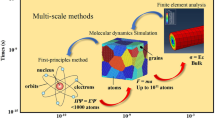Abstract
Molecular dynamics (MD) simulation and the finite element (FE) method are two popular numerical techniques for the simulation of machining processes. The two methods have their own strengths and limitations. MD simulation can cover the phenomena occurring at nano-metric scale but is limited by the computational cost and capacity, whilst the FE method is suitable for modelling meso- to macro-scale machining and for simulating macro-parameters, such as the temperature in a cutting zone, the stress/strain distribution and cutting forces, etc. With the successful application of multi-scale simulations in many research fields, the application of simulation to the machining processes is emerging, particularly in relation to machined surface generation and integrity formation, i.e. the machined surface roughness, residual stress, micro-hardness, microstructure and fatigue. Based on the quasi-continuum (QC) method, the multi-scale simulation of nano-metric cutting has been proposed. Cutting simulations are performed on single-crystal aluminium to investigate the chip formation, generation and propagation of the material dislocation during the cutting process. In addition, the effect of the tool rake angle on the cutting force and internal stress under the workpiece surface is investigated: The cutting force and internal stress in the workpiece material decrease with the increase of the rake angle. Finally, to ease multi-scale modelling and its simulation steps and to increase their speed, a computationally efficient MATLAB-based programme has been developed, which facilitates the geometrical modelling of cutting, the simulation conditions, the implementation of simulation and the analysis of results within a unified integrated virtual-simulation environment.
Similar content being viewed by others
References
Dornfeld D, Min S, Takeuchi Y (2006) Recent advances in mechanical micromachining. Ann CIRP 55(2):745–768. doi:10.1016/j.cirp.2006.10.006
Yan J, Strenkowski J (2006) A finite element analysis of orthogonal rubber cutting. J Mater Process Technol 174(1–3):102–108. doi:10.1016/j.jmatprotec.2005.02.265
Mamalis AG, Horvath M, Branis AS, Manolakos DE (2001) Finite element simulation of chip formation in orthogonal metal cutting. J Mater Process Technol 110:19–27
Simoneau A, Ng E, Elbestawi MA (2006) Chip formation during microscale cutting of a medium carbon steel. Int J Mach Tools Manuf 46:467–481. doi:10.1016/j.ijmachtools.2005.07.019
Shi G, Deng X, Shet C (2002) A finite element study of the effect of friction in orthogonal metal cutting. Finite Elem Anal Des 38:863–883. doi:10.1016/S0168-874X(01)00110-X
Shiari B, Miller RE, Klug DD (2007) Multiscale simulation of material removal processes at the nanoscale. J Mech Phys Solids 55:2384–2405. doi:10.1016/j.jmps.2007.03.018
Cheng K, Luo X, Ward R, Holt R (2003) Modelling and simulation of the tool wear in nanometric cutting. Wear 255(7-12):1427–1432
Komanduri R, Chandrasekaran N, Raff LM (2000) MD simulation of nanometric cutting of single crystal aluminium-effect of crystal orientation and direction of cutting. Wear 242:60–88. doi:10.1016/S0043-1648(00)00389-6
Komanduri R, Chandrasekaran N, Raff LM (1999) Orientation effects in nanometric cutting of single crystal materials: an MD simulation approach. Ann CIRP 48:67–72. doi:10.1016/S0007-8506(07)63133-3
Baskes MI (1981) Interatomic potentials and crystalline defects. Proceedings of a Symposium, Fall Meeting of the Metallurgical Society of AIME
Khlhoff S, Gumbsch F, Fischmeister HF (1991) Crack propagation in b.c.c. crystals studied with a combined finite-element and atomistic model. Philos Mag 64A:851–878
Rafii-Tabar H, Hua L, Cross M (1998) A multi-scale atomistic-continuum modelling of crack propagation in a two-dimensional macroscopic plate. J Phys Condens Matter 10:2357–2387. doi:10.1088/0953-8984/10/11/003
Robert R (2000) Coupling of length scales in MEMS modelling the atomic limit of finite element. Proc. of SPIE, May 9–11, 2000, pp 16–25
Pillai AR, Miller RE (2001) Crack behaviour at bi-crystal interfaces: a mixed atomistic and continuum approach. Mater Res Soc Symp Proc 653:Z2.9.1–Z2.9.7
Liu X, Devor RE, Kapoor SG et al (2004) The mechanics of machining at the microscale: assessment of the current state of the science. Trans ASME J Manuf Sci Eng 126:666–678. doi:10.1115/1.1813469
Sun X, Chen S, Cheng K, Huo D, Chu W (2006) Multiscale simulation on nanometric cutting of single crystal aluminum. Proc Inst Mech Eng B J Eng Manuf 220(7):1217–1222. doi:10.1243/09544054JEM540SC
Tadmor EB, Ortiz M, Phillips R (1996) Quasicontinuum analysis of defects in crystals. Philos Mag A 73:1529–1563
Shan D, Yuan L, Guo B (2005) Multiscale simulation of surface step effects on nanoindentation. Mats Sci Eng A 412:264–270. doi:10.1016/j.msea.2005.08.198
Luo X (2004) High Precision surfaces generation: modelling, simulation and machining verification. PhD Thesis, Leeds Metropolitan University.
Author information
Authors and Affiliations
Corresponding author
Rights and permissions
About this article
Cite this article
Sun, X., Cheng, K. Multi-scale simulation of the nano-metric cutting process. Int J Adv Manuf Technol 47, 891–901 (2010). https://doi.org/10.1007/s00170-009-2125-5
Received:
Accepted:
Published:
Issue Date:
DOI: https://doi.org/10.1007/s00170-009-2125-5




